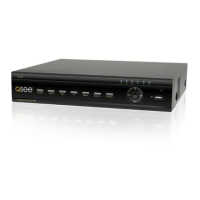
Do you have a question about the Q-See QT426 and is the answer not in the manual?
Safety guidelines for electrical installation and operation.
Precautions for handling during transport and storage.
Guidelines for proper installation of the DVR.
Requirements for service and repair personnel.
Recommended operating temperature and environmental conditions.
Guidance on using recommended accessories.
Conditions not covered by the product warranty.
Overview of the DVR's technology and intended applications.
Key features including compression, surveillance, recording, and backup.
DVR alarm input/output and scheduling capabilities.
Features for controlling PTZ cameras.
User management, rights, and access control.
Supported network protocols and connectivity options.
Step-by-step guide for installing a SATA hard drive.
Description of buttons and indicators on the DVR's front panel.
Description of connectors and ports on the DVR's rear panel.
Instructions for using the remote control and its buttons.
How to use the mouse for navigation and operations.
Procedures for powering the DVR on and off.
Process of logging into the DVR system with user credentials.
How to view live video feeds from connected cameras.
How to play back recorded video footage.
Settings for system, date, time, and DST.
Settings for live view display and camera color adjustment.
Settings for enabling and configuring video recording.
Setting up recording schedules for motion and alarms.
Settings for various alarm types including sensor, motion, video loss.
Configuring network settings like IP address, DNS, PPPoE, DDNS.
Managing user accounts, types, and access permissions.
Configuring Pan-Tilt-Zoom (PTZ) device settings.
Searching for recorded video by date and time.
Searching for recorded events based on type (motion, sensor).
Managing recorded files, including lock, unlock, and delete.
Backing up recorded data to USB flash drive or HDD.
Viewing hardware, firmware, and device information.
Detailed system information like hardware and firmware versions.
Reviewing recorded events based on selected date.
Checking system logs for user activity and operations.
Viewing current network parameters and status.
Checking details of currently connected online users.
Reviewing parameters for manual alarm triggers.
Managing hard disk drives, including formatting.
Accessing the DVR over a local network.
Methods for setting up remote access (DHCP, Static IP, PPPoE, DDNS).
Configuring router ports for remote DVR access.
Configuring browser settings for remote DVR access.
How to connect and use the DVR via browser.
Remotely playing back recorded video and performing backups.
Remotely configuring DVR settings.
Accessing DVR from Windows Mobile Pro phones.
Accessing DVR from Symbian phones.
Accessing DVR via SuperCam software on iPhones.
DVR compression format and parameters.
Video input, output, resolution, and frame rate specifications.
Audio input/output specifications.
Alarm input and output specifications.
Supported storage modes and disk types.
Network and communication interface specifications.
PTZ and remote control support.
Disk type and capacity specifications.
Voltage and working temperature specifications.
Troubleshooting power-on issues.
Troubleshooting display output issues.
Troubleshooting missing camera images.
Troubleshooting issues with the DVR not detecting the HDD.
Troubleshooting recording failures.
Troubleshooting mouse connectivity and functionality.
Troubleshooting system hang-up issues.
Clarification on front USB port usage.
Instructions for inputting passwords and numbers.
Steps to upgrade DVR firmware via USB.
Troubleshooting menu display issues.
Troubleshooting TV output issues.
PC requirements for remote client access.
PC requirements for 16-channel remote access.
List of tested compatible USB drive brands and capacities.